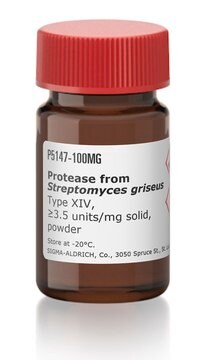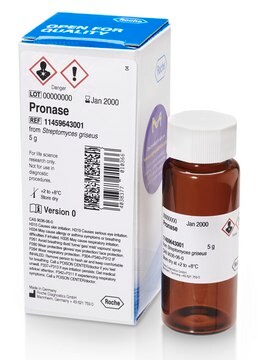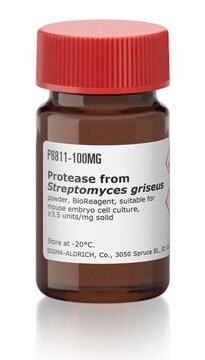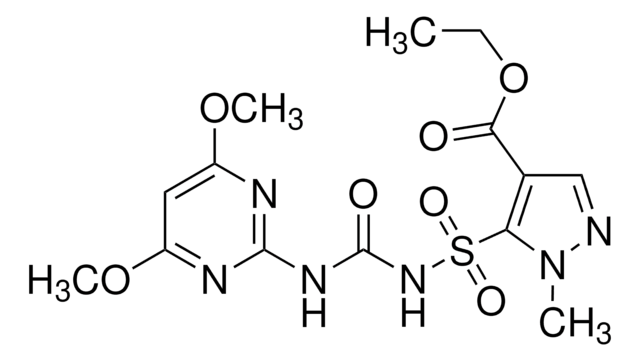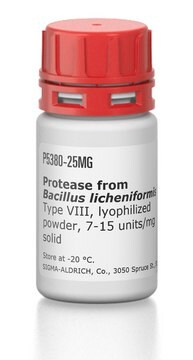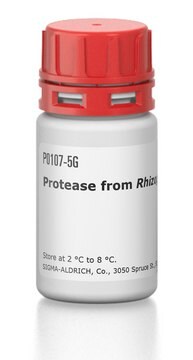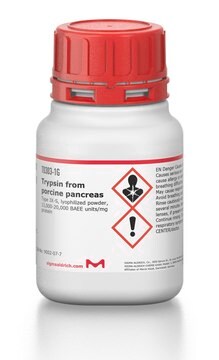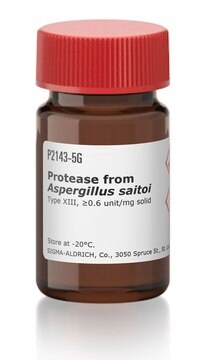53702
Pronase® Protease, Streptomyces griseus
Synonym(s):
Pronase® powder
Sign Into View Organizational & Contract Pricing
All Photos(1)
About This Item
Recommended Products
form
lyophilized
Quality Level
specific activity
≥45,000 proteolytic units/g dry wt
manufacturer/tradename
Calbiochem®
storage condition
OK to freeze
desiccated (hygroscopic)
solubility
water: 10 mg/mL
shipped in
ambient
storage temp.
2-8°C
General description
A non-specific protease liquefies mucins and digests proteins to free amino acids. Can be used to isolate living chondrocytes. Most active at neutral pH, but it is stable over a wide pH and temperature range. Has an optimal pH of 7.5. Note: 1 KU = 1000 units.
A non-specific protease liquefies mucins and digests proteins to free amino acids. Can be used to isolate living chondrocytes. Most active at neutral pH, but stable over wide range of pH and temperature. Note: 1KU = 1000 units.
Note: 1 KU = 1000 units.
Warning
Toxicity: Harmful (C)
Unit Definition
One unit is defined as the amount of enzyme that will liberate a digestion product equivalent to 25 µg of tyrosine per min at 40°C, pH 7.5.
Physical form
Lyophilized from a solution containing calcium acetate as a stabilizer.
Reconstitution
Following reconstitution, store in the refrigerator (4°C). Stock solutions are stable for 24 h at 4°C.
Other Notes
Narahashi, Y., et al. 1968. J. Biochem. 64, 427.
Legal Information
CALBIOCHEM is a registered trademark of Merck KGaA, Darmstadt, Germany
PRONASE is a registered trademark of Merck KGaA, Darmstadt, Germany
Signal Word
Danger
Hazard Statements
Precautionary Statements
Hazard Classifications
Eye Irrit. 2 - Resp. Sens. 1 - Skin Irrit. 2 - STOT SE 3
Target Organs
Respiratory system
Storage Class Code
11 - Combustible Solids
WGK
WGK 2
Certificates of Analysis (COA)
Search for Certificates of Analysis (COA) by entering the products Lot/Batch Number. Lot and Batch Numbers can be found on a product’s label following the words ‘Lot’ or ‘Batch’.
Already Own This Product?
Find documentation for the products that you have recently purchased in the Document Library.
Customers Also Viewed
W N Ross et al.
The Journal of neuroscience : the official journal of the Society for Neuroscience, 4(3), 659-672 (1984-03-01)
Optical techniques using voltage-sensitive dyes were used to record electrical events simultaneously from many positions on certain neurons of the barnacle supraesophageal ganglion. By signal-averaging, recordings with good signal-to-noise ratios and time resolution were obtained from fine dendritic processes as
T E Davis et al.
Infection and immunity, 15(3), 978-987 (1977-03-01)
Enzymes capable of hydrolyzing cell walls of Blastomyces dermatitidis and chemotypes I and II of Histoplasma capsulatum were prepared in the laboratory or obtained from commercial sources. They included chitinases, beta-1,3-glucanases, beta-1,6-glucanase, and Pronase. Monosaccharides and disaccharides of glucose released
Saurabh Dahiya et al.
Human molecular genetics, 20(22), 4345-4359 (2011-08-19)
Matrix metalloproteinases (MMPs) are a group of extracellular proteases involved in tissue remodeling in several physiological and pathophysiological conditions. While increased expression of MMPs (especially MMP-9) has been observed in skeletal muscle in numerous conditions, their physiological significance remains less-well
M Tsacopoulos et al.
The Journal of neuroscience : the official journal of the Society for Neuroscience, 17(7), 2383-2390 (1997-04-01)
Glial cells transform glucose to a fuel substrate taken up and used by neurons. In the honeybee retina, photoreceptor neurons consume both alanine supplied by glial cells and exogenous proline. Ammonium (NH4+) and glutamate, produced and released in a stimulus-dependent
S Kästner et al.
The journal of histochemistry and cytochemistry : official journal of the Histochemistry Society, 48(8), 1079-1096 (2000-07-18)
Satellite cells are the myogenic precursors in postnatal muscle and are situated beneath the myofiber basement membrane. We previously showed that fibroblast growth factor 2 (FGF2, basic FGF) stimulates a greater number of satellite cells to enter the cell cycle
Our team of scientists has experience in all areas of research including Life Science, Material Science, Chemical Synthesis, Chromatography, Analytical and many others.
Contact Technical Service